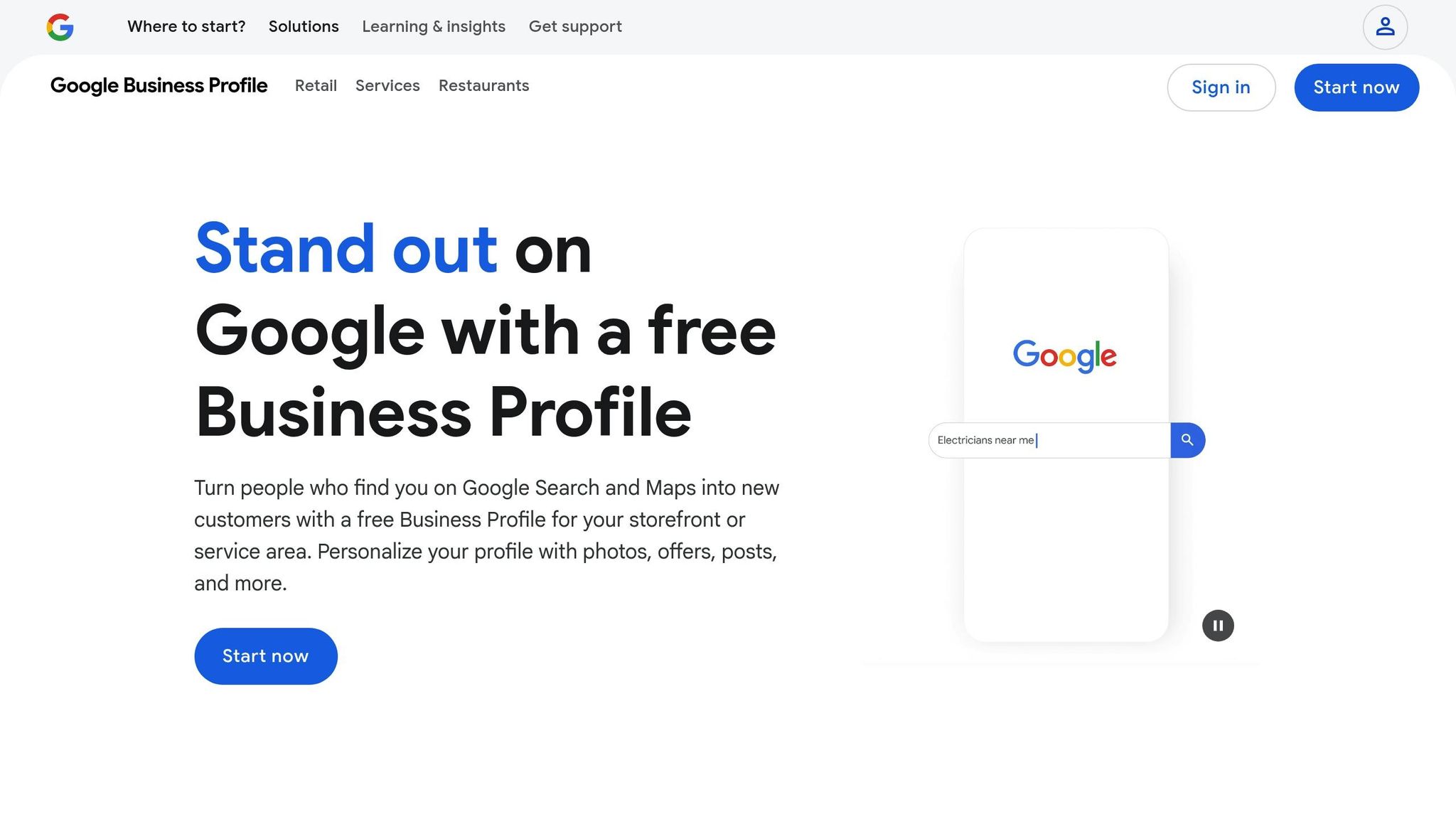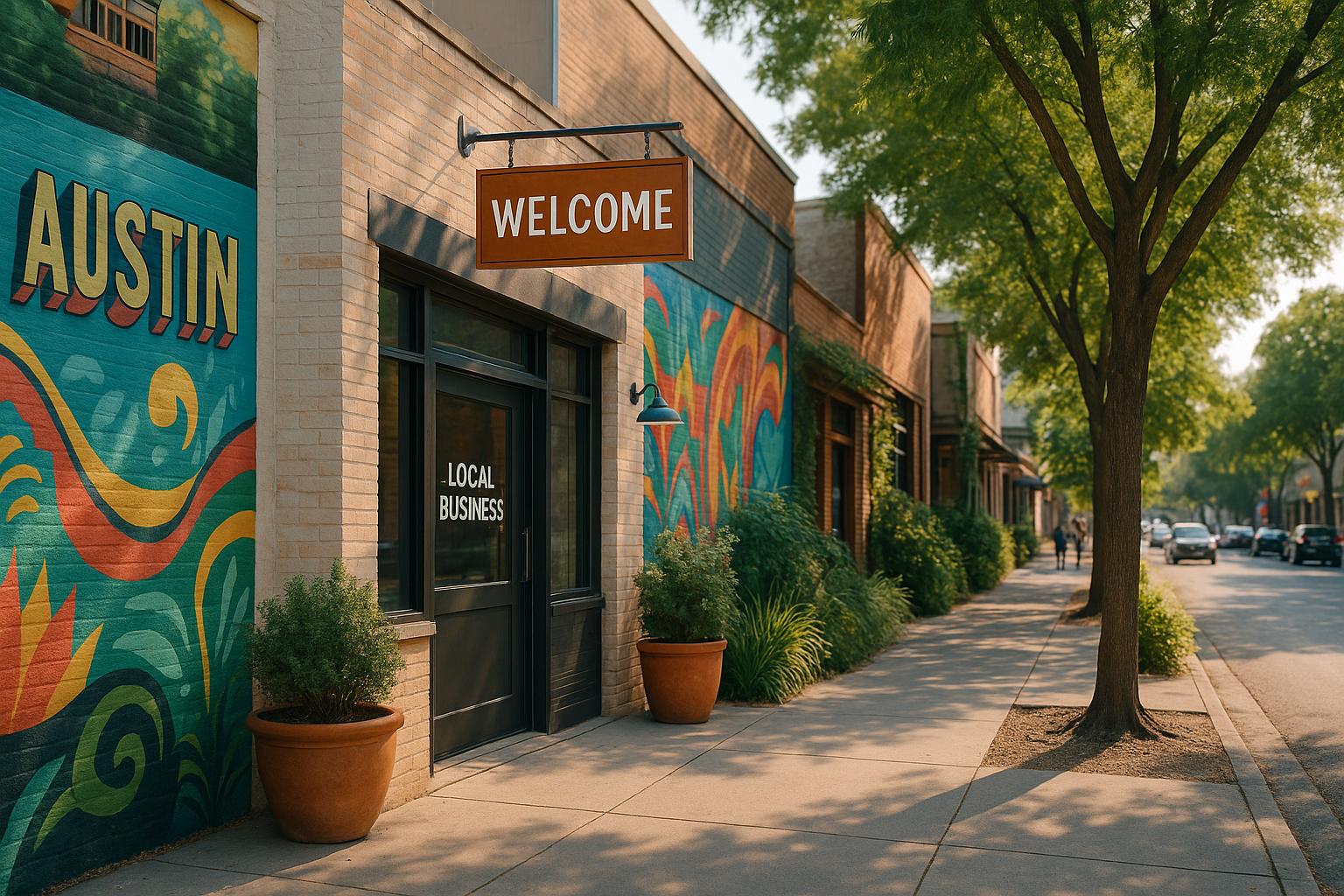Want to reach more customers in Austin? Focus on hyperlocal SEO.
Hyperlocal SEO targets specific neighborhoods like Sixth Street and South Congress, helping businesses connect with customers searching for nearby options. Instead of broad searches like "restaurants in Austin", it focuses on precise queries such as "coffee shop on East 6th Street" or "boutiques on South Congress."
Here’s how to make it work:
- Use specific keywords: Include phrases like "live music Sixth Street" or "best lunch South Congress" to match local search habits.
- Optimize your Google Business Profile: Add photos, hours, and descriptions that reflect the vibe of your neighborhood.
- Create local content: Write guides, event posts, and location-specific pages to attract nearby customers.
- Engage with the community: Partner with local businesses, sponsor events, or pitch stories to Austin media for backlinks.
- Track results: Monitor keywords, traffic, and customer actions by neighborhood for better targeting.
For businesses in Austin, hyperlocal SEO is a game-changer for standing out in competitive areas.
Understanding Sixth Street and South Congress for Hyperlocal SEO
Austin’s neighborhoods each have their own personality, and that means hyperlocal SEO strategies need to reflect these differences. Sixth Street and South Congress are two prime examples, each offering distinct vibes that shape how people search for things to do, places to eat, and more. Let’s break down what makes these areas stand out.
Sixth Street: The Heart of Nightlife and Entertainment
Known as Austin’s go-to spot for nightlife, Sixth Street is packed with bars, live music venues, and entertainment options. It’s the place where the city’s energy comes alive after dark. However, concerns about safety in this area make it important for businesses to build trust through their online presence. Emphasizing transparency and a safe environment in your SEO strategy can help you connect with this audience while addressing their priorities.
South Congress: A Hub for Shopping and Dining
South Congress Avenue, or "SoCo", is a mix of eclectic shops, trendy restaurants, and a dash of Austin’s signature quirkiness. It draws both locals and visitors looking for unique retail experiences and memorable dining. Businesses here can use hyperlocal SEO to highlight their connection to the area’s charm and community spirit, showcasing what makes them a true part of the SoCo experience. Tailoring your strategy to reflect this neighborhood’s character can help you stand out to a diverse audience.
Hyperlocal Keyword Research and Content Strategies
Building on the distinct vibes of Sixth Street and South Congress, these strategies ensure your online presence connects with the local audience. Hyperlocal SEO in Austin means recognizing that search habits vary by neighborhood. For instance, someone searching for a bar on Sixth Street will approach it differently than someone hunting for vintage shops on South Congress. Your keywords should reflect this local intent.
Conducting Hyperlocal Keyword Research
Use neighborhood-specific modifiers. Instead of broad terms like "best restaurants Austin", focus on phrases such as "late night eats Sixth Street" or "brunch spots South Congress." These longer, more targeted keywords often face less competition and attract users who are ready to take action.
Leverage Google’s autocomplete feature to uncover what locals are searching for. Begin typing "Sixth Street" or "South Congress" alongside your business type, and note the most common suggestions. This simple, free tool offers a glimpse into real search behaviors.
Analyze local search patterns by identifying the questions people have about your neighborhood. Queries like "Is Sixth Street safe at night?" or "Where to park on South Congress" can guide your content strategy. For deeper insights, tools like SearchX’s keyword research service can help you pinpoint opportunities that larger competitors might overlook.
Monitor seasonal and event-driven keywords that gain traction during Austin’s big events. Phrases like "SXSW bars Sixth Street" or "ACL weekend South Congress shopping" can draw significant traffic during peak times. Use Google Trends to track these patterns and align your content calendar with the city’s event schedule.
By focusing on precise local keywords, you’ll be ready to create content that speaks directly to each neighborhood’s character.
Creating Neighborhood-Specific Content
Develop detailed location pages that go beyond basic business details. Instead of a generic "Austin location" page, create unique pages like "Our Sixth Street Location" or "Our South Congress Store." Highlight parking options, nearby attractions, and what makes each spot special to visitors.
Write neighborhood guides to showcase your local expertise. For example, a South Congress restaurant could create "The Ultimate SoCo Food Crawl", featuring their location along with other local gems. These guides not only attract curious visitors but can also earn backlinks when other websites reference them.
Produce event-specific content that ties your business to local happenings. A Sixth Street venue might publish posts like "Navigating Sixth Street During SXSW" or "Top Pre-Game Spots Before UT Football Games." This type of content positions your business as a go-to resource during high-traffic events.
Optimize for natural Q&A phrases such as "What’s open late on Sixth Street?" Structure your content in a conversational, question-and-answer format that reflects how people talk, especially when using voice search.
Once your content is tailored to the neighborhood, you can make it even more engaging by weaving in local language and references.
Using Local Language and References
Include Austin slang and familiar terms to connect with the community. For instance, use "SoCo" for South Congress, "Dirty Sixth" for the main entertainment strip, or nods to "Keep Austin Weird." These phrases not only make your content feel authentic but also improve its relevance for local searches.
Mention local landmarks and specific locations to boost geographic relevance. Instead of vague phrases like "near downtown", say "between 4th and 6th Streets" or "across from the State Capitol." These details help search engines understand your location and serve your content to the right audience.
Highlight collaborations with other local businesses or community efforts. For example, mention partnerships with South Congress shops or spotlight local artists performing on Sixth Street. These connections build trust with your audience and reinforce your local presence in search results.
Address neighborhood-specific concerns and interests. Sixth Street businesses could discuss safety tips and late-night transportation, while South Congress shops might focus on eco-friendly practices or supporting local artisans. By aligning with the values and needs of your community, your content will resonate more deeply with your audience.
Optimizing Google Business Profile and Local Listings

Your Google Business Profile serves as a digital storefront, especially for hyperlocal Austin searches. In a city as dynamic and competitive as Austin, having a well-optimized profile can make all the difference. When someone searches for "coffee shops near Sixth Street" or "vintage stores South Congress", your profile could be the deciding factor in whether your business shows up in these key local results.
Setting Up and Optimizing Google Business Profile
Pick the most specific business category. Instead of going broad with "Restaurant", narrow it down to something like "Tex-Mex Restaurant" or "BBQ Restaurant" to better describe your offerings. Google uses these categories to match your business with the most relevant searches.
Write a targeted business description that includes local landmarks. For example, instead of a generic description, try something like: "Family-owned taco shop serving authentic Mexican food to Sixth Street visitors and downtown workers since 2018" or "Vintage clothing boutique showcasing local Austin designers, located in the heart of South Congress." These neighborhood references can make your profile stand out.
Add photos that capture the local vibe. Include exterior shots that feature well-known Austin landmarks or street signs, along with interior images that showcase your space during busy times. High-quality visuals not only make your profile more engaging but can also lead to more clicks for directions or website visits.
Highlight features that matter to Austin customers. Think about what your audience values. For example, businesses on Sixth Street could emphasize late-night hours or safety measures, while South Congress shops might focus on parking availability or eco-friendly practices. Mentioning amenities like outdoor seating, Wi-Fi, or credit card acceptance can also resonate with locals and visitors alike.
Adapt your hours for major Austin events. Events like SXSW, ACL, or UT football games often bring a surge in foot traffic. Adjust your hours to reflect these changes, whether it’s staying open late or noting temporary closures. This keeps potential customers informed and avoids frustration.
Once your profile is optimized, the next step is ensuring your business details are consistent across all platforms.
Maintaining Local Listing Consistency
Keep your NAP details uniform across directories. NAP stands for Name, Address, and Phone number. Even small inconsistencies, like using "Street" in one listing and "St." in another, can confuse search engines and weaken your local SEO. Ensure your business details match across platforms, including local directories like the Austin Chamber of Commerce, Do512, and Austin360.
Regularly check for updates or errors. Sometimes competitors or automated systems can alter your business information without your knowledge. This can hurt your rankings and confuse customers. Setting up Google Alerts for your business name and periodically reviewing your listings can help you catch and fix issues quickly.
Consistency across platforms builds trust, which can be further strengthened by leveraging customer reviews.
Using Customer Reviews for Local Credibility
Respond to every review quickly and thoughtfully. Austin customers value businesses that engage with their community. Replying to both positive and negative feedback shows you care about their experience and helps maintain a strong online reputation.
Make it easy for customers to leave reviews. Encourage satisfied customers to share their experiences while the memory is fresh. You can provide direct links to your Google Business Profile or use QR codes that make the process seamless.
Use review responses to highlight your local roots. When replying, reference Austin-specific details or neighborhood landmarks. For example, thank someone for visiting your South Congress location or mention the vibrant Sixth Street atmosphere.
Address recurring feedback in your profile updates. If reviews frequently mention parking challenges on South Congress, add parking details to your profile. Similarly, if customers comment on noise levels at your Sixth Street location, update your profile to include information about quieter seating options.
Customer reviews also give you a chance to naturally incorporate keywords. For example, when customers mention phrases like "best tacos on Sixth Street" or "unique gifts on South Congress", these terms can reinforce your local relevance and signal to Google that your business is a perfect match for similar searches. This fine-tuned local optimization works hand-in-hand with the broader keyword strategies we’ve covered earlier.
sbb-itb-880d5b6
Building Local Backlinks and Community Presence
Strengthen your local SEO and reputation by securing trusted Austin backlinks and actively participating in the city’s dynamic community. This involves getting local websites to link back to your business and becoming a recognized part of Austin’s vibrant ecosystem.
Getting Backlinks from Local Sources
Pitch newsworthy stories to local media.
Local outlets like the Austin Chronicle, Austin Business Journal, and neighborhood blogs are always on the lookout for engaging stories. Whether you’re celebrating a milestone, launching a community project, or introducing an innovative service, these platforms can amplify your visibility while providing valuable backlinks.
Offer expert commentary to local journalists.
Establish yourself as a thought leader by sharing insights with reporters covering Austin-related topics. For example, if you own a restaurant on Sixth Street, your take on dining trends or how events like SXSW impact the local scene can make you a go-to resource.
Join local business organizations.
Membership in groups like the Austin Chamber of Commerce, South Austin Business Association, or East Austin Business Association often comes with directory listings, complete with backlinks to your site. These connections can give your local SEO a boost.
Collaborate with other Austin businesses.
Partner with complementary businesses for co-branded events or promotions. For instance, a South Congress boutique might team up with a local coffee roaster for a pop-up event, creating opportunities for backlinks from event listings and partner websites.
Engage with Austin influencers and bloggers.
Work with local food bloggers, lifestyle influencers, or community advocates who have strong followings. Their reviews, features, or collaborative posts can drive traffic to your site while generating valuable backlinks.
Contribute guest posts to local blogs.
Share your expertise by writing for Austin-focused blogs or publications. Topics like industry trends or your business’s unique story can resonate with the local audience and earn you a byline with a link to your site.
Get recognized in local awards and “Best of Austin” lists.
When your business is featured in annual “Best of Austin” lists – like those from Austin Monthly – or wins local awards, make sure these mentions include a link to your website. This recognition not only boosts your credibility but also strengthens your search rankings.
Partner with educational institutions.
Consider offering scholarships to students at The University of Texas at Austin or other local colleges. This not only supports the community but can also lead to valuable .edu backlinks.
These strategies can be further amplified by building relationships with community organizations.
Engaging with Community Organizations
Sponsor local events and festivals.
Sponsoring events is a great way to connect with the community while earning backlinks. Beyond major festivals like SXSW and ACL, consider supporting neighborhood events, school fundraisers, or non-profit galas.
"Sponsoring an Austin festival, a local school’s fun run, or a non-profit gala can earn you backlinks from their websites. Austin’s strong non-profit sector offers many such opportunities. This not only builds links but also enhances your community image." – Diffyweb
Measuring Hyperlocal SEO Performance
To gauge the success of your hyperlocal SEO efforts, focus on detailed metrics that connect online activity to offline results. These metrics build upon the earlier steps of refining your Google Business Profile and local listings.
Tracking Local Search Rankings and Traffic
Keep an eye on neighborhood-specific keyword rankings. Instead of generic terms, track how your business performs for searches like "coffee shop South Congress" or "live music Sixth Street." Tools like SearchX can help you break down rankings by Austin neighborhoods, showing where you’re excelling and where there’s room for growth.
Use location-based segments in Google Analytics. By analyzing visitors from specific Austin zip codes, you can determine whether your Sixth Street SEO strategy is drawing customers from that area – or attracting people from other parts of the city.
Evaluate "near me" search performance. Google Search Console’s performance reports can reveal how location-based queries with modifiers like "near me" are performing and how click-through rates differ depending on the type of search.
Analyze local pack rankings for specific terms. For example, your position in the local pack for "restaurants near Sixth Street" may vary between neighborhoods. Understanding these differences can guide your strategy adjustments.
Pay attention to mobile traffic trends from target neighborhoods. Austin’s unique foot traffic patterns – like weekend crowds on South Congress or the late-night buzz on Sixth Street – often show up in mobile search behaviors.
Dive into Google Business Profile insights. Look at the "queries used to find your business" section to identify which neighborhood-specific searches are driving traffic and customer visits.
Once you’ve assessed search rankings and traffic, shift your focus to conversion metrics to measure the real-world impact of your efforts.
Measuring Conversion Metrics
Create location-specific conversion goals. Tailor goals to reflect customer behavior in different neighborhoods. For instance, a Sixth Street bar might prioritize tracking event bookings, while a South Congress boutique might focus on both online sales and in-store visits.
Track phone calls from hyperlocal searches. Use call tracking numbers on your Google Business Profile and local directories to monitor calls generated by searches like "coffee shop South Congress."
Measure in-store visits via Google Analytics. This feature tracks users who click on your website and later visit your physical location – a key metric for Austin businesses, where many local searches lead to offline visits.
Monitor local reviews and social media engagement. Pay attention to review rates from customers in different neighborhoods and interactions on location-tagged social media posts to see how well your business resonates locally.
Evaluate performance of local citations. Track click-through rates from sources like Austin Chamber of Commerce listings or neighborhood association websites to measure your relevance in local contexts.
Calculate customer lifetime value by neighborhood. Assess whether customers acquired through hyperlocal SEO efforts in specific Austin areas differ in spending habits or loyalty. This insight can help you allocate resources to the most profitable neighborhoods effectively.
Key Takeaways for Hyperlocal SEO Success in Austin
Here’s how you can sharpen your hyperlocal SEO game in Austin:
Focus on neighborhood-specific keywords. Use terms that directly reference areas like "Sixth Street" or "South Congress." For example, targeting phrases such as "coffee near South Congress" can help you connect with users ready to take action. This approach works better than competing for broad citywide searches, especially for small businesses.
Adapt your Google Business Profile to match the neighborhood’s vibe. Tailor your profile to reflect what makes each area unique. Sixth Street businesses should highlight nightlife, live music, and late-night hours, while South Congress spots should emphasize shopping, dining, and bustling weekend activity. Use photos, descriptions, and business hours that align with the local character.
Build local connections through backlinks and community involvement. Collaborate with nearby businesses, sponsor events, or partner with neighborhood associations. For instance, a South Congress boutique linking to a neighboring restaurant benefits both businesses’ SEO while fostering community ties. These connections make your content more relevant locally.
Create content that speaks to Austin’s personality. Reference landmarks, events, and local culture that resonate with your target neighborhoods. For example, South Congress businesses might mention the State Capitol, while Sixth Street establishments could highlight the Red River District. This shows you understand the area and its audience.
Track success with neighborhood-specific data. Monitor rankings for hyperlocal keywords, analyze traffic from specific zip codes, and measure calls from location-based searches. Dive deeper by tracking in-store visits and customer lifetime value by neighborhood to identify which areas bring the most profitable customers.
Keep your NAP consistent across all platforms. Your business name, address, and phone number (NAP) should match perfectly across directories like Google Business Profile, Yelp, and the Austin Chamber of Commerce. Inconsistent details can confuse both search engines and potential customers.
Encourage reviews that mention local details. Reviews that highlight specific experiences, like "perfect spot after shopping on South Congress", carry more weight for hyperlocal SEO than generic comments. These reviews boost your credibility in the area.
The secret to mastering hyperlocal SEO in Austin lies in recognizing that Sixth Street and South Congress attract different audiences with unique search behaviors. By tailoring your strategy to each neighborhood, you can capture more hyperlocal searches and connect with the right customers.
FAQs
How can businesses on Sixth Street use hyperlocal SEO to address safety concerns and attract customers?
Businesses can leverage hyperlocal SEO to emphasize safety measures and build trust with their community. A great starting point is updating your Google Business Profile. Highlight safety features like upgraded lighting, on-site security staff, or collaborations with local law enforcement. These updates not only reassure potential customers but also enhance your visibility in local search results.
You can take it a step further by creating localized content that addresses safety. Write blog posts or share social media updates about improvements in the area, such as added security measures or community safety initiatives. Highlighting events or efforts that promote a safer environment shows your business is actively engaged and committed to the well-being of the community. This approach can strengthen your reputation as a reliable and caring local presence.
How can I create content that reflects the unique vibe of South Congress in Austin?
To truly reflect the essence of South Congress, focus on celebrating its lively atmosphere, artistic charm, and strong sense of community. Spotlight iconic spots like the Congress Avenue Bridge, highlight local events, and showcase the neighborhood’s quirky shops and diverse dining options. Use visuals that capture Austin’s creative and relaxed vibe – think colorful street art, live music scenes, or the buzz of outdoor markets.
Storytelling plays a big role here. Share real stories about the people and businesses that give South Congress its unique character. Incorporating user-generated content or teaming up with local influencers can add a relatable, personal angle that connects with the community. Stay genuine and shine a light on what makes South Congress such a cherished part of Austin.
How can businesses track the success of their hyperlocal SEO efforts in Austin’s neighborhoods?
Businesses looking to measure the success of their hyperlocal SEO efforts in Austin should keep an eye on a few key metrics: local search rankings, website traffic from targeted neighborhoods, and leads or conversions tracked through Google Business Profile insights.
Tools like Google Analytics and Google Search Console are invaluable for keeping tabs on traffic and engagement from neighborhood-specific searches. Beyond that, monitoring customer actions – such as phone calls, requests for directions, and reviews – can reveal how effectively your business is resonating with local audiences.
Regularly reviewing these metrics enables businesses to pinpoint what’s working and make strategic adjustments to boost visibility and draw in more nearby customers.




